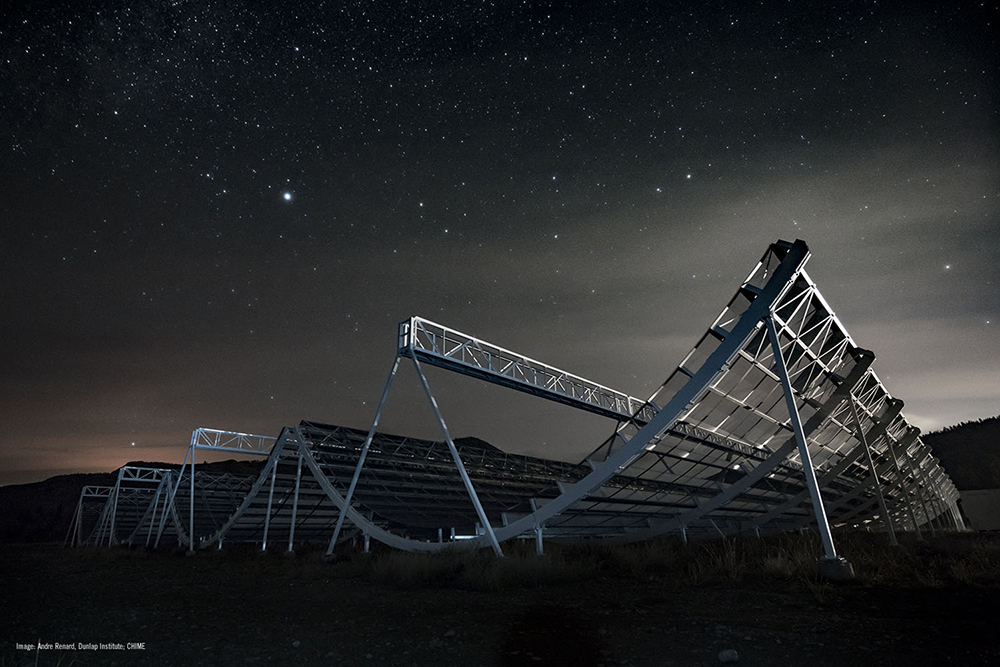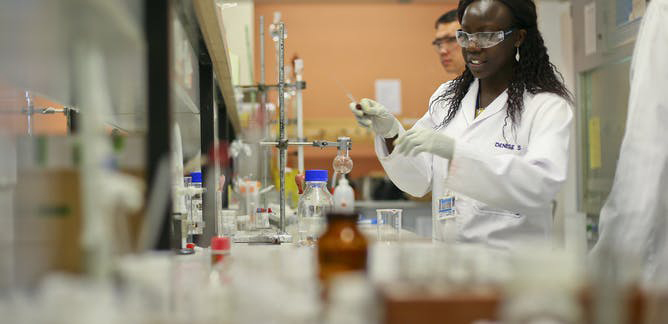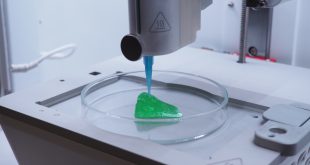At the frontier of theoretical physics
By Jana Manolakos
When he took the helm as Director of the Perimeter Institute in Waterloo, Ontario, last year, Robert Myers urged his team of intrepid theoretical physicists to “be bold, be adventurous, be audacious in our aspirations to advance humanity through exceptional science.” And they took up the call.
At the Institute, considered the world’s largest research hub for theoretical physics, they ask big questions – and gather big data. It’s no longer just about chalk marks on a blackboard. As computers advance and numbers grow with the emergence of new algorithms, information and ideas, so does the need for computational power to manage the onslaught of data. It’s a problem that theoretical physicists at Perimeter are facing head on.

Foundational theoretical physics is a cornerstone of modern quantitative science, on which so much else rests. The field advances the fundamental understanding of the universe, and triggers new technologies. Solar cells, machine learning and artificial intelligence (AI), GPS, wireless technologies and diagnostic imagery – they are all rooted in physics.
Housed in a 120,000-sq.ft. ultramodern building on the shore of Silver Lake, the Institute – which was founded in 1999 – has added training and outreach to its research mission. With costs covered by a public-private sector arrangement that includes funding from both the Ontario and federal governments, the nonprofit ran on a budget of $33 million last year.
Myers admits, “It’s astonishing how much of the research conducted at Perimeter today would have been impossible, even unthinkable, 20 or 10 or even five years ago.” By all accounts, the numbers are impressive. Last year, Perimeter’s research community included 365 scientists and 512 scientific visitors. In the last 13 years, 1,000 young scientists received training and last year alone, 459 papers were published. “Perimeter is an environment unlike any other, in which researchers from around the globe collaborate across disciplines in search of profound new truths,” Myers adds.
From exploring the infinitesimal to seeing the infinite, this work generates vast amounts of data; but storing and analyzing it has challenges.
Reeling in data
A deluge of data was gathered by 50 scientists from Perimeter, McGill, the University of Toronto, the University of British Columbia and the National Research Council of Canada, through their work on the Canadian Hydrogen Intensity Mapping Experiment (CHIME). Located in BC’s Okanagan Valley, CHIME is the first new Canadian telescope in decades (pictured above). Last year, its powerful scans helped scientists get a better handle on detecting fast radio bursts (FRBs) – a mysterious cosmic phenomenon. In the course of scanning the universe for these barely detectable bursts, CHIME unleashed a tsunami of information for researchers to sift through.
“It’s too much to save to disk, so you only get to look at it during a little window of time when it’s in memory,” explains Kendrick Smith, a leading cosmologist on the Perimeter team. “You need big supercomputers on site, doing real-time processing for every analysis we want to do – including FRBs.”
Read more: Canada’s supercomputers are pushing the limits of discovery
With a first PhD in math, a second in cosmology and a stint as a software engineer in between, Smith applied physics, data analysis, statistics and pure mathematics to find the signals in the wave of data generated by CHIME. He developed several game-changing algorithms for sorting and analyzing the data, then implemented this new mathematics as software. The result was an FRB search that ran 100 times faster than anyone expected, and turned the CHIME telescope into the world’s best FRB hunter. Smith says, “We basically turned high-precision radio astronomy into a software problem.” His work on this project earned him the 2020 New Horizons in Physics prize.
In another project, Perimeter faculty member Robert Spekkens and postdoctoral researchers Elie Wolfe and Tobias Fritz have used approaches inspired by fundamental quantum physics to create a new tool for identifying cause and effect. It’s central to the work of researchers, and it’s not as easy as it sounds.
Take health data, for example. Medical researchers might test a cancer drug and find high rates of recovery for women over the age of 60. Is that because the drug works, or because women over 60 have a higher likelihood of spontaneous remission? Without careful analysis, the data can’t tell you which explanation is the right one. Dr. Spekkens and his colleagues have introduced a new framework that helps researchers drill down to the minutiae of cause and effect to gain greater accuracy. This type of thinking, some of it algorithmic in nature, has contributed to AI and the understanding of complex systems.

It’s something that Roger Melko, the Director of the Perimeter Institute Quantum Intelligence Lab (PIQuIL, affectionately pronounced “Pickle”), and his team are taking forward as they explore the use of AI algorithms in quantum physics. Researchers at the lab – located off-site in Waterloo’s Quantum Valley – routinely work with real data from quantum computing laboratories and collaborate with colleagues in such institutions as the Vector Institute for Artificial Intelligence, the University of Waterloo, the National Research Council and Canadian startup 1Qbit.
Melko, who also holds the Canada Research Chair in Computational Many-Body Physics, explains, “What makes this lab so unique is its focus on fundamental research and quantum technologies. We perform scientific research at the intersection of quantum physics and artificial intelligence, and produce open-source codes that can be used by groups, labs and industries around the world.”
It is at this very point of convergence between physics and quantum technology that the race to build quantum computers has heated up. A quantum computer harnesses quantum mechanics to deliver huge leaps forward in processing power, even beyond that of today’s supercomputers. Quantum computers and the data they generate, using subatomic particles, are capable of untold discoveries, from new materials to new vaccines.
As computers advance, so does the need for safety, according to Perimeter’s Michele Mosca, a leading cryptologist who specializes in cyber-immunity for high-performance computers. In addressing the federal government’s Public Safety Committee last year, he warned that current means of encrypting data would not withstand attacks by quantum computers.
“Canada is actually a world leader in quantum science, in cryptography, in quantum-safe cryptography – by which I mean, cryptography designed to be safe against quantum attacks in cybersecurity,” he explains. While large-scale quantum computers are still several years into the future, Mosca sees value in preparing for when they dawn.
And when they do, the Perimeter Institute will be there.
Buchalter Cosmology Prize awarded to Perimeter Institute for sixth consecutive year
The Buchalter Cosmology Prize is an annual prize that supports the development of new theories, observations or methods to help illuminate the puzzle of cosmic expansion. It recognizes ground-breaking theoretical, observational or experimental work in cosmology.
Researchers at the Perimeter Institute have won the prize annually since its launch in 2014.
This year, it went to Perimeter Associate Faculty member Niayesh Afshordi for his paper, “Echoes from the Abyss,” which examines a black hole created by the merger of two neutron stars. The Buchalter judging panel called it “a bold and innovative step towards understanding quantum gravitational phenomena.”
In the classical version of Einstein’s general relativity, black holes are surrounded by event horizons – the famous “points of no return” from which nothing, not even light, can escape. However, many aspects of these mysterious phenomena appear not to mesh with quantum mechanics, which describes physics at the particle level. This is why black holes have become “labs,” in a sense, for finding ways to reconcile general relativity and quantum mechanics, the two pillars of modern physics.
The quantum nature of event horizons (which appear to contain all of the information within black holes) is still shrouded in mystery. One branch of research aims to unravel the mystery by studying how ripples of spacetime, called gravitational waves, might scatter off this quantum structure, leading to delayed repeating “echoes” during the creation of black holes, which can happen after two neutron stars collide.
Afshordi and his co-author Jahed Abedi (Albert Einstein Institute) found the first statistically significant detection of these echoes in gravitational wave data by LIGO (the Laser Interferometer Gravitational-Wave Observatory). The data were obtained one second after LIGO’s first detected merger of two neutron stars on August 17, 2017.
“If correct, this would radically alter the classical picture of black holes and will be the first direct signature of quantum effects in gravity,” said Afshordi in a news release issued by the Perimeter Institute.
Afshordi says he had his colleagues dedicate their work to the memories of late scientists Stephen Hawking and Joe Polchinski, both of whom championed the black hole information paradox “and much of theoretical physics as we know it.”
The annual prize was created in 2014 by Dr. Ari Buchalter, an entrepreneur with a background in astrophysics.
 BioLab Business Magazine Together, we reach farther into the Canadian Science community
BioLab Business Magazine Together, we reach farther into the Canadian Science community





